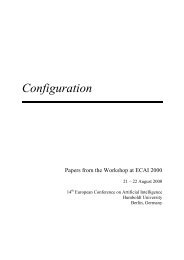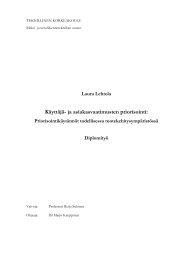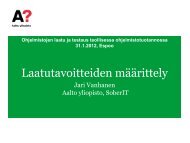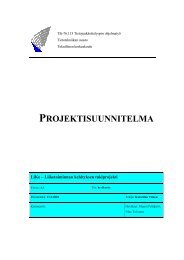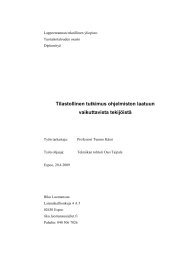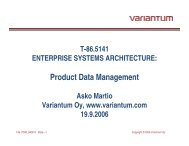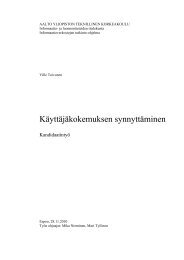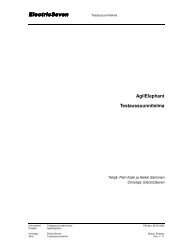The diagram 6.2 shows the sequence of actions executed in loan approval process. WApplicant2Requestcontainer1634Loan approverWeb servie4Approvalcontainer1: Applicant sends message2: Message is s<strong>to</strong>red in request container3 & 4: Invocation of Web serviced5: Message from invocation is s<strong>to</strong>red in approval container6: Result is sent <strong>to</strong> applicantFigure 6.2: The sequence of actions executed in loan approval processThe <strong>BPEL</strong> process can be run from <strong>BPEL</strong> engine which has been available in the market (See section 2.1)7. CONCLUSIONS<strong>BPEL</strong> is convergence of language features of IBM’s WebService Flow Language (WSFL) <strong>and</strong>Microsoft’s XLANG. As an XML-based language, <strong>BPEL</strong> describes the logic <strong>to</strong> coordinate Web servicesin a process flow. <strong>BPEL</strong> was first proposed by Microsoft, IBM <strong>and</strong> BEA as <strong>BPEL</strong>4WS in August 2002.On 12 April 2007 <strong>BPEL</strong> 2.0 was approved as OASIS <strong>st<strong>and</strong>ard</strong>. <strong>BPEL</strong> process needs <strong>to</strong> be run via <strong>BPEL</strong>engines, which have been developed by several vendors.<strong>BPEL</strong>-WS provides a <strong>st<strong>and</strong>ard</strong> language for business orchestration <strong>and</strong> execution. By using <strong>BPEL</strong> itmakes integration with business partners easier <strong>and</strong> more effective, it also leas <strong>to</strong> further processoptimization.However, <strong>BPEL</strong> does not cover human interaction. To support a broaden range of scenarios, <strong>BPEL</strong>extensions are required. In June 2007, Active Endpoints, Adobe, BEA, IBM, Oracle <strong>and</strong> SAP publishedthe <strong>BPEL</strong>4People specifications, which define an approach for integrating human interactions using WS-<strong>BPEL</strong> 2.0. The specifications will be sent <strong>to</strong> OASIS for approval in the near future
Besides excluding people action, <strong>BPEL</strong> does not interaction between sub-process <strong>and</strong> parent processeither. In September 2005, IBM <strong>and</strong> SAP published a white paper called Extensions for Sub-Processes(<strong>BPEL</strong>-SPE). The paper recognizes the problem of process reused in <strong>BPEL</strong>, describes differentinvocation scenarios <strong>and</strong> coordination mechanisms between parent process <strong>and</strong> sub/process. However, noconsensus on how the problem should be resolved. Many efforts still need <strong>to</strong> be made before <strong>BPEL</strong>-SPEspecification is finalized.In order <strong>to</strong> improve the interaction between IT <strong>and</strong> business process management, EU founded projectSUPER was kicked off on 1st April 2006. The project intends <strong>to</strong> adopt Semantic Web Servicestechnology <strong>to</strong> enable business <strong>to</strong> use information technology more efficiently <strong>and</strong> <strong>to</strong> make cooperationbetween IT <strong>and</strong> business better.8. REFERENCE[1] Matjaz B. Juric, A H<strong>and</strong>s-on <strong>Introduction</strong> <strong>to</strong> <strong>BPEL</strong>, accessed 09 DEC 2007,URL: http://www.oracle.com/technology/pub/articles/matjaz_bpel1.html[2] Wikipedia, 2007, Business Process Execution Language, accessed 09 DEC 2007,URL: http://en.wikipedia.org/wiki/Business_Process_Execution_Language[3] 2005, Business Process Executive Language, accessed 09 DEC 2007,URL: http://www.expresscomputeronline.com/20050321/technology05.shtml[4] Chris<strong>to</strong>ph Schittko, 2003, XML conference & Exposition, Web Service Orchestration with <strong>BPEL</strong>,accessed 09 DEC 2007,URL: http://www.idealliance.org/papers/dx_xml03/papers/04-06-01/04-06-01.html[5] Michael Cobban, 2004, What is <strong>BPEL</strong> <strong>and</strong> why is it so important <strong>to</strong> my business? accessed 09 DEC2007,URL: http://www.softcare.com/whitepapers/wp_whatis_bpel.php[6] Oracle White Paper, 2004, Orchestrating Web Sevices: The case for a <strong>BPEL</strong> Server, accessed 09 DEC2007,URL: http://www.oracle.com/technologies/integration/pdf/bpel-case-whitepaper.pdf[7] 2007, The approval of WS-<strong>BPEL</strong> as OASIS <strong>st<strong>and</strong>ard</strong>, accessed 09 DEC 2007,URL: http://www.oasis-open.org/cn/news/2007_04_12.htm[8] Ta’id Holmes, 2007, <strong>BPEL</strong>4People: extending WE-<strong>BPEL</strong> for People, accessed 09 DEC 2007,URL:http://bpel4people.svn.sourceforge.net/viewvc/%2Acheckout%2A/bpel4people/doc/thesis/thesis.pdf?revision=1,[9] 2007, WS-<strong>BPEL</strong> Extension for People, accessed 09 DEC 2007,URL:http://www.ibm.com/developerworks/webservices/library/specification/ws-bpel4people/[10] Yoichi Takayama, 2007, WS-<strong>BPEL</strong> Extension for People, accessed 09 DEC 2007,URL:http://wiki.ramp.org.au/confluence/display/workflow/WS-<strong>BPEL</strong>+Extension+for+People+(<strong>BPEL</strong>4People)[11] Wikipedia, 2007, <strong>BPEL</strong>4People, accessed 09 DEC 2007,URL: http://en.wikipedia.org/wiki/<strong>BPEL</strong>4People[12] 2007, <strong>BPEL</strong>4People Specifications Integrate Human Interactions In<strong>to</strong> Business Process, accessed 09DEC 2007,URL: http://xml.coverpages.org/ni2007-06-25-a.html[13] Ashish Agrawal, etal., 2007, WS-<strong>BPEL</strong> Extension for People Version 1.0,http://xml.coverpages.org/<strong>BPEL</strong>4People-V1-200706.pdf[14] Ashish Agrawal, etal., 2007, Web Services Human Task Version1.0, accessed 09 DEC 2007,URL: http://xml.coverpages.org/WS-HumanTask-V1-200706.pdf



